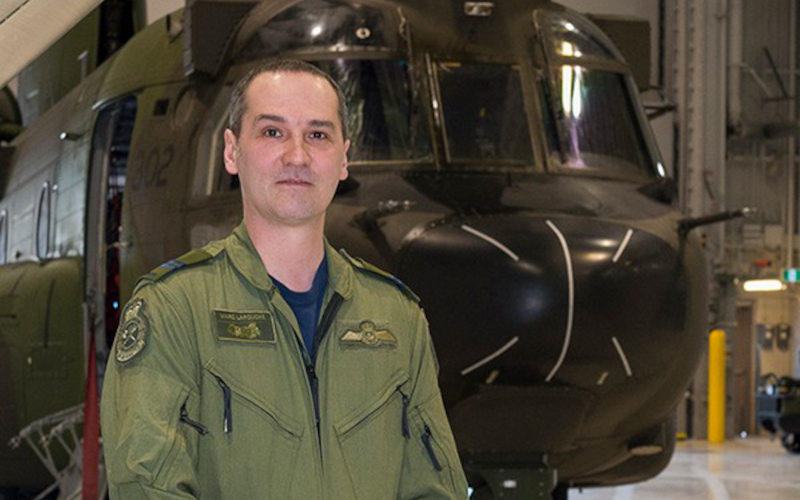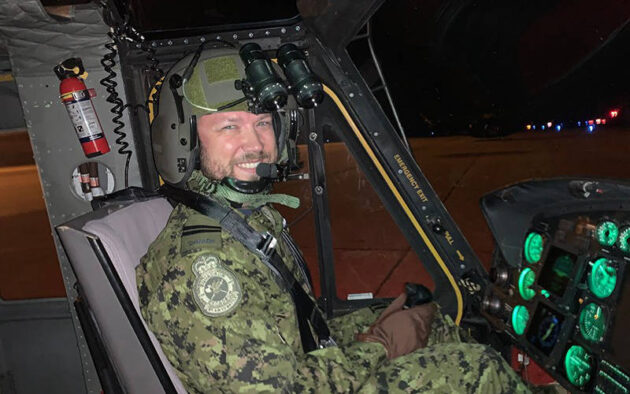
Features
Military
‘Mentor to everyone’: Captain killed in Chinook crash was loyal husband, dad, friend
June 26, 2023 By Sarah Ritchie, The Canadian Press
 Captain Marc Larouche, 53, originally of Amos, Quebec. (Photo: Canadian Armed Forces)
Captain Marc Larouche, 53, originally of Amos, Quebec. (Photo: Canadian Armed Forces) OTTAWA — Capt. Marc Larouche had a calm presence.
Being a keen, silent observer of what was going on around him, speaking only when he needed to, was part of what made him a great pilot and leader in the Royal Canadian Air Force.
He also did not say much to Annie on their first blind date.
It took some time, and a few more dates, for him to open up, but she quickly realized they had something special.
“I discovered a humble and simple guy, easygoing and funny. I knew very soon that he was the man of my life,” said Dr. Annie Larouche, a dentist in Pembroke, Ont., and Marc’s wife of 22 years.
Capt. Marc Larouche and Capt. David Domagala were both killed in a helicopter crash in eastern Ontario on Tuesday.

Captain David Domagala, 32, originally of Woodstock, Ontario. (Photo: Canadian Armed Forces)
They, along with two colleagues from 450 Tactical Helicopter Squadron, left Garrison Petawawa for a nighttime training flight. Somehow, their CH-147F Chinook crashed into the Ottawa River, about 160 kilometres northwest of Canada’s capital city.
The military is just beginning its investigation into what happened.
Annie and their three sons, Maxim, 22, Guillaume, 21, and Marc-Antoine, 18, shared their memories of Marc with The Canadian Press through an emailed statement and handwritten notes Friday that were sent through a friend of the family.
Marc, 53, was originally from Amos, Que. He got his private pilot’s licence before joining the Armed Forces in 1989. He received his pilot’s wings four years later.
His postings took him across the country — from Chilliwack, B.C., to Portage-La-Prairie, Man., to Burton, N.B. — and around the world. He deployed to Somalia in 1993 as part of Operation Deliverance, and was part of Operation Podium during the 2010 Winter Olympics and Paralympics in Vancouver.
Military careers are notably tough on families, especially ones with young kids.
But Marc was loyal and dedicated.
“We went through hell and back together over the years, but he never gave up on us,” Annie said.
He also loved nature and being outside, and was a fan of anything with a motor. His boys called his tractor his “mistress.” He couldn’t wait to get out and plow snow off the roads near their home.
He owned four chainsaws — that we know of, his sons said — and he knew how to fix pretty much anything. If a car broke down, the Larouche family didn’t bother with a tow truck. They called Marc.
Marc had a quiet approach to fatherhood: standing back to let his boys make mistakes, but always ready to help if they asked.
If he didn’t know something, he would study until he learned it and was ready to share his knowledge.
That also made him a great mentor and teacher at work.
“He was approachable, and a mentor to everyone,” his friend and colleague Capt. Steve Doughty wrote in an email.
The pair met in 2000 when they were both posted to 427 Squadron in Petawawa, and when Marc joined 450 Squadron in 2016 and started flying the Chinooks, he convinced his friend to join him.
“I loved flying with him. He was an incredible pilot. A fantastic instructor. A calm and steady guy and my best friend at the squadron,” Doughty said.
Marc was named the squadron’s chief instructor in 2017. In addition to the Chinook, he flew the CH-135 Twin Huey and the CH-146 Griffon, amassing more than 6,700 flying hours during his 33 years of service.
He was awarded a Command Commendation from the Canadian Special Forces Operations Command for outstanding service to the Special Operations Aviation Squadron.
“I will hold him in my heart until I meet him again on the other side. Rest in peace my love,” Annie said.
The Royal Canadian Air Force released the names of both Larouche and Domagala on Friday with permission from their families. Domagala’s family requested privacy but shared his biography.
The 32-year-old was from Woodstock, Ont., and joined the reserves in 2008 before attending Royal Military College.
He graduated with a bachelor of arts degree in 2016, and returned to his studies in recent years. He was nearing completion of a master’s degree from the college.
Domagala earned his wings in 2019 and joined the 450 Squadron that year. His flying career was briefly interrupted when he volunteered for a yearlong deployment to Egypt as a liaison officer for Operation Calumet, a peacekeeping operation Canada has been part of since 1985.
He received a Commander Commendation from the Canadian Joint Operations Command for his work on that mission.
Domagala started training to fly the Chinooks once he returned from Egypt.
Two other crew members survived Tuesday’s crash and were treated in hospital for minor injuries.
The remainder of 450 Squadron had been on an operational pause as a result of the crash, but flying operations resumed Friday.
The military was conducting environmental containment and cleanup on the river as the Air Force’s directorate of flight safety worked to remove the helicopter, which was under about 21 metres of water.
A spokesperson for the Defence Department said in an email that river currents and poor visibility in the water were making that a complex undertaking. There was a black box flight recorder on board the aircraft.
Chinook helicopters are intended for transporting personnel and equipment, and have been used in response to natural disasters and emergencies across the country.
Canada’s CH-147F version has been modified specifically for long-haul flights with a larger fuel capacity.
Last year, the U.S. air force temporarily grounded its fleet of Chinooks after fuel leaks caused a number of engine fires. No one was injured in those incidents.
A spokesperson for the Defence Department said the Royal Canadian Air Force was in contact with U.S. counterparts and the manufacturer, Boeing, but there were no such incidents reported on the Canadian aircraft and no work was required on the Canadian fleet.
As of Friday afternoon, there had been no word on what may have caused Tuesday’s crash.